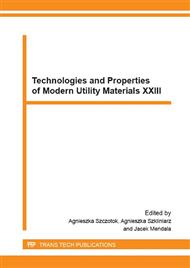[1]
S. Świłło, P. Czyżewski, J. Lisok, M. Chamera, Advanced computer based techniques and methods in process design for large car-body parts, Advanced metal forming processes in automotive industry, in: Proc. of the 3st International Lower Silesia - Saxony Conference, 13-16 May 2012, Wroclaw, Poland, (ed. Z. Gronostajski), pp.85-96.
Google Scholar
[2]
S. Świłło, P. Czyżewski, J. Lisok, An experimental study for hydro-bulging process using advance computer technique, in: Proc. of the 14th International Conference on Metal Forming, 2012, Cracow, Poland (eds.: J. Kusiak, J. Majta, D. Szeliga), Steel Res. Int. spec. ed. pp.1611-3683.
Google Scholar
[3]
J. Lisok, The use of finite element simulation for analysis of pressing charges laser welded (in Polish), PhD thesis, Silesian University of Technology, Katowice, Poland, (2003).
Google Scholar
[4]
B. Micieta, V. Binasova, L. Kubinec, Analysis using of classic energy sources, in: Proc. of Conference 'Pokrokove priemyselne inzinierstvo InvEnt 2014, Industrial Engineering – Navigating the future, EDIS – Žilina University Publisher, pp.140-143.
Google Scholar
[5]
J. Lisok, L. Wojtynek, R. Zagórski, SPC system in assessing the quality of the production of car body selected item, in: Proc. of Conference Pokrokove priemyselne inzinierstvo - InvEnt 2010, Žilina Georg Publisher, pp.204-217.
Google Scholar
[6]
J. Matuszek, E. Golińska, The issue of costs of operations for a selected position of the assembly of cars, in: Proc. of Conference Pokrokove priemyselne inzinierstvo - InvEnt 2010, Žilina Georg Publisher, pp.234-243.
Google Scholar
[7]
E. Chlebus, CAx computer techniques in manufacturing engineering, WNT, Warszawa (2000).
Google Scholar
[8]
X.Y. Zhang, X.L. Jin, Y.Y. Li, G.G. Li, Improvement design of the main Energy-absorbing Automotive parts based on Traffic Accident Analysis, Mater. Design 29 (2005) 403-410.
DOI: 10.1016/j.matdes.2007.01.022
Google Scholar
[9]
T. Link, C. Jensen, Three-Point Bending Crash Performance of Advanced High Strength Steels, SAE Technical Paper 2009-01-0797, 2009, doi: 10. 4271/2009-01-0797.
DOI: 10.4271/2009-01-0797
Google Scholar
[10]
L. Qing-fen, W. Hai-dou, L. Yan-jie, Y. Sheng-yuan, Finite Element Analysis and Shape Optimization of Automotive Crash-box Subjected to Low Velocity Impact, 2009 International Conference on Measuring Technology and Mechatronics Automation, 2009, pp.791-794.
DOI: 10.1109/icmtma.2009.545
Google Scholar
[11]
A. Rusineka, R. Zaerab, P. Forquina, J.R. Klepaczkoa, Effect of plastic deformation and boundary conditions combined with elastic wave propagation on the collapse site of a crash box, Thin Wall. Struct. 46 (2008) 1143–1163.
DOI: 10.1016/j.tws.2008.01.009
Google Scholar
[12]
M. Pilarczyk, T. Wieczorek, A. Tomaszewski, Fault detection system on car assembly line, in: Proc. of Conference 'Pokrokove priemyselne inzinierstvo - InvEnt 2014: Industrial Engineering – Navigating the future, EDIS – Žilina University Publisher, pp.144-147.
Google Scholar
[13]
A. Pal, J.P. Singh, P. Dutta, The effect of speed variation on different Traffic Paterns in Mobile Ad Hoc Network, Procedia Technol. 4 (2012) 743-748.
DOI: 10.1016/j.protcy.2012.05.121
Google Scholar


